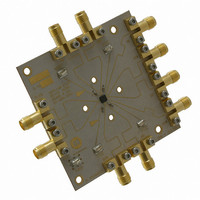NB7L14MMNEVB ON Semiconductor, NB7L14MMNEVB Datasheet - Page 5

NB7L14MMNEVB
Manufacturer Part Number
NB7L14MMNEVB
Description
EVAL BOARD FOR NB7L14MMN
Manufacturer
ON Semiconductor
Datasheet
1.NB7L14MMNR2G.pdf
(11 pages)
Specifications of NB7L14MMNEVB
Main Purpose
Timing, Clock Buffer / Driver / Receiver / Translator
Embedded
No
Utilized Ic / Part
NB7L14M
Primary Attributes
Input Up To 12Gb/s & 8GHz
Secondary Attributes
Differential CML Output
Lead Free Status / RoHS Status
Lead free / RoHS Compliant
Other names
NB7L14MMNEVBOS
NOTE: Device will meet the specifications after thermal equilibrium has been established when mounted in a test socket or printed circuit
9. Measured by forcing V
10. Duty cycle skew is measured between differential outputs using the deviations of the sum of Tpw− and Tpw+ @1 GHz.
11. Device to device skew is measured between outputs under identical transition @ 1 GHz.
12. Additive RMS jitter with 50% duty cycle clock signal at 10 GHz.
13. Additive peak−to−peak data dependent jitter with input NRZ data at PRBS 2
14. V
Table 5. AC CHARACTERISTICS
Symbol
V
f
t
t
t
t
V
t
t
data
PLH
PHL
SKEW
JITTER
r
f
OUTPP
INPP
Input edge rates 40 ps (20% − 80%).
INPP
,
board with maintained transverse airflow greater than 500 lfpm. Electrical parameters are guaranteed only over the declared
operating temperature range. Functional operation of the device exceeding these conditions is not implied. Device specification limit
values are applied individually under normal operating conditions and not valid simultaneously.
(MAX) cannot exceed V
Output Voltage Amplitude (@V
(See Figure 4)
Maximum Operating Data Rate
Propagation Delay to Output Differential
Duty Cycle Skew (Note 10)
Within−Device Skew
Device−to−Device Skew (Note 11)
RMS Random Clock Jitter (Note 12)
Peak/Peak Data Dependent Jitter f
(Note 13)
Input Voltage Swing/Sensitivity
(Differential Configuration) (Note 14)
Output Rise/Fall Times @ 1 GHz
(20% − 80%)
INPP
450
400
350
300
250
200
150
100
Characteristic
(TYP) from a 50% duty cycle clock source. All loading with an external R
50
0
Input Clock Frequency (f
CC
1
− V
Figure 3. Output Voltage Amplitude (V
2
EE
(V
CC
INPPmin
. Input voltage swing is a single−ended measurement operating in differential mode.
= 2.375 V to 3.465 V, V
3
in
f
data
f
= 2.488 Gb/s
) f
data
V
V
f
f
f
CC
CC
in
in
in
in
= 10 Gb/s
4
= 5 Gb/s
= 6 GHz
= 8 GHz
≤ 6 GHz
≤ 8 GHz
= 3.3 V
= 2.5 V
INPUT FREQUENCY (GHz)
Q, Q
http://onsemi.com
(V
5
INPP
in
) at Ambient Temperature (Typical)
Min
280
125
10
70
75
6
= 400 mV)
5
EE
−40°C
= 0 V; Note 9)
7
Typ
400
300
110
400
2.0
6.0
0.2
0.2
2.0
5.0
6.0
12
20
30
8
^23
2500
Max
150
5.0
0.5
0.5
5.0
8.0
15
50
10
60
−1.
OUTPP
9
Min
280
125
10
70
75
10
) versus
25°C
Typ
400
300
400
110
2.0
6.0
0.2
0.2
2.0
5.0
6.0
12
20
30
11
2500
L
Max
150
5.0
0.5
0.5
5.0
8.0
15
50
10
60
12
= 50 W to V
Min
280
125
10
70
75
CC
85°C
Typ
400
300
110
400
2.0
6.0
0.2
0.2
2.0
5.0
6.0
.
12
20
30
2500
Max
150
5.0
0.5
0.5
5.0
8.0
15
50
10
60
Gb/s
Unit
mV
mV
ps
ps
ps
ps










